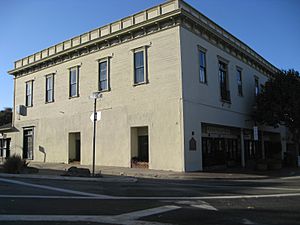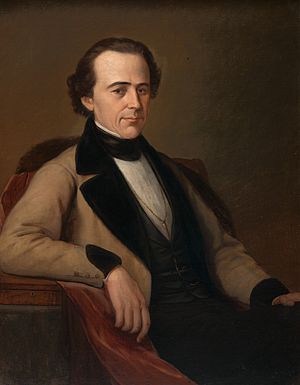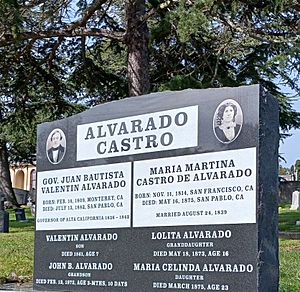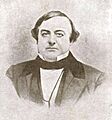Juan Bautista Alvarado facts for kids
Quick facts for kids
Juan Bautista Alvarado
|
|
|---|---|
 |
|
| 8th Governor of the Californias | |
| In office 1837–1842 |
|
| Preceded by | Nicolás Gutiérrez |
| Succeeded by | Manuel Micheltorena |
| President of Alta California (Unrecognized) |
|
| In office 1836–1837 |
|
| Personal details | |
| Born | February 14, 1809 Monterey, California |
| Died | July 13, 1882 (aged 73) San Pablo, California |
| Spouse | María Martina Castro de Alvarado |
| Profession | Politician, ranchero, rebel |
Juan Bautista Valentín Alvarado y Vallejo (born February 14, 1809 – died July 13, 1882) was an important leader in early California. He was a "Californio," meaning he was born in California when it was part of Mexico. Alvarado became the Governor of Alta California from 1837 to 1842.
Before becoming governor, Alvarado briefly led a movement for California's independence. From 1836 to 1837, he helped remove the acting governor, Nicolás Gutiérrez. He even declared California independent and created a new flag and a set of rules. Later, he made an agreement with the Mexican government. This agreement recognized him as governor and ended the independence movement.
Contents
Early Life and Education
Alvarado was born in Monterey, which was then part of Alta California. His parents were Jose Francisco Alvarado and María Josefa Vallejo. Sadly, his father passed away a few months after Juan Bautista was born. His mother remarried three years later.
Juan Bautista was raised by his grandparents on his mother's side. He grew up with his cousin, Mariano Guadalupe Vallejo. Both boys were taught by William Edward Petty Hartnell, an English merchant living in Monterey.
In 1827, when he was 18, Alvarado became a secretary for the local government. In 1829, he and his friends, Vallejo and José Castro, were briefly arrested. This happened during a military uprising led by Joaquín Solis.
Supporting Mission Changes
Alvarado supported changes to the Spanish missions in California. These changes were called "secularization." This meant the missions would no longer be controlled by the church. Instead, their lands would be given to people.
In 1834, Alvarado was chosen to be a delegate in the legislature. He also became a customs inspector in Monterey. Governor José Figueroa gave Alvarado a large piece of land called Rancho El Sur in 1834. This ranch was about 9,000 acres, south of Monterey.
Leading an Independence Movement
After Governor Figueroa died in 1835, Nicolás Gutiérrez became the acting governor. He was later replaced by Mariano Chico, but Chico was not popular. Chico left California, and Gutiérrez took over as governor again.
However, Californios, like Alvarado, wanted more control over their land. In November 1836, Alvarado and Castro, with support from Vallejo and a group of Americans led by Captain Isaac Graham, started a revolt. They forced Governor Gutiérrez to leave the country.
Alvarado's group wrote a new set of rules for California. They also adopted a new flag. This flag had a single red star on a white background. However, these were not used after Alvarado made peace with Mexico.
Alvarado Becomes Governor

At just 27 years old, Alvarado was appointed governor. However, the city council of Los Angeles did not agree with this. Alvarado, Castro, and Graham traveled south. After three months, they reached an agreement, which helped avoid a civil war.
Then, the city council of San Diego also disagreed with Alvarado's revolt. This time, the Mexican government was involved. There were rumors that the Mexican Army might step in. Alvarado was able to negotiate another agreement to keep the peace.
However, Mexico later changed its mind. They appointed Carlos Antonio Carrillo as governor in December 1837. Carrillo was very popular in Southern California. This led to a civil war. After several battles, Carrillo was forced out. Finally, Mexico agreed and recognized Alvarado as the official governor.
Alvarado married Doña Martina Castro on August 24, 1839, in Santa Clara. He did not attend his own wedding. His half-brother, Jose Antonio Estrada, stood in for him. After the wedding, Alvarado lived with his wife in Monterey.
During his time as governor, Alvarado gave away much of the mission lands. These lands were given to important Californio families. He did not take any land for himself. He traded his Rancho El Sur for another ranch, Rancho Bolsa del Potrero y Moro Cojo. He later sold this ranch. In 1841, he bought Rancho El Alisal near Salinas from his former teacher, William Hartnell.
In April 1840, Alvarado heard about a plan for a revolt. This revolt was supposedly led by a group of foreigners, including his former ally, Isaac Graham. Alvarado ordered their arrest and sent them to Mexico City for trial. They were later found not guilty in June 1841.
Also in 1841, leaders in the United States talked about "Manifest Destiny." This idea suggested that the U.S. should expand across North America. Californios became worried about these intentions. Vallejo, Castro, and Alvarado asked Mexico to send more soldiers to California. They wanted to strengthen Mexico's control.
Tensions in California

In response to the Californios' request, Mexican President Antonio López de Santa Anna sent Brigadier General Manuel Micheltorena to California in January 1842. Micheltorena brought 300 men with him. He was supposed to become the new governor and military commander.
In October 1842, before Micheltorena reached Monterey, an American naval officer, Thomas ap Catesby Jones, made a mistake. He thought that war had started between the U.S. and Mexico. He sailed into Monterey Bay and demanded that the Presidio of Monterey surrender. Micheltorena's forces were still in the south, and the Monterey presidio did not have enough soldiers. Alvarado reluctantly surrendered and went to his ranch, Rancho El Alisal. The next day, Jones realized his mistake. Alvarado refused to return as governor and told Jones to speak with Micheltorena instead.
Micheltorena eventually arrived in Monterey. However, he had trouble controlling his soldiers, many of whom were convicts. This led to rumors of a revolt. By 1844, Alvarado was linked to those who were unhappy. Micheltorena ordered Alvarado's arrest. But Alvarado's detention was short. Micheltorena needed everyone to help prepare for a possible war against the U.S.
This situation turned against Micheltorena. On November 14, 1844, a group of Californios revolted against Mexican authority. Manuel Castro led this group, with José Castro and Alvarado commanding the troops. A truce was agreed upon, and Micheltorena promised to send away his convict soldiers. However, Micheltorena broke the agreement, and fighting began again. The rebels won the Battle of Providencia in February 1845 near the Los Angeles River. Micheltorena and his troops then left California.
Pío Pico became the new governor in Los Angeles. José Castro became the military commander. Later, Alvarado was chosen to join the Mexican Congress. He planned to move to Mexico City, but Pico did not provide money for the move. Relations between Northern and Southern California became worse.
John C. Frémont arrived in Monterey in early 1846. Fearing foreign invasion, Castro gathered his militia, with Alvarado as second in command. However, Frémont went north to Oregon. The political situation in Mexico was unstable. This caused more problems among the Californios, and it seemed that a civil war might break out between the north and south of California.
American Conquest and Later Life
On July 7, 1846, American Commodore John D. Sloat took control of Monterey. He announced that the Mexican–American War had begun. Pico, Castro, and Alvarado put aside their differences to focus on the American threat. However, by the end of August, Pico and Castro fled to Mexico, and Alvarado was captured. After being released, Alvarado spent the rest of the war at his estate in Monterey.
After the war, Alvarado was offered the governorship again, but he declined. Instead, he retired to his wife Martina's family estate at Rancho San Pablo in 1848. Alvarado did not take part in the California Gold Rush. He focused on farming and business instead. He opened the Union Hotel on the ranch in 1860, but most of his businesses were not successful.
After Martina's death in 1876, Alvarado wrote his Historia de California (History of California). He passed away on his ranch in 1882. He is buried at Saint Mary Cemetery in Oakland.
Alvarado's old adobe house in downtown Monterey is still standing. It is now a California Historical Landmark. The former town of Alvarado (now part of Union City) was named after him. Alvarado Street in San Francisco's Noe Valley is also named in his honor. Parts of the Rancho San Pablo adobe are now part of the government campus in San Pablo. Alvarado Park within Wildcat Canyon Regional Park is also named for him.
Images for kids
See also
 In Spanish: Juan Bautista Alvarado para niños
In Spanish: Juan Bautista Alvarado para niños
- California Historical Landmarks in Monterey County
- History of California through 1899
- Revolt of 1837 (New Mexico)
- Republic of the Rio Grande
- Republic of Yucatan



